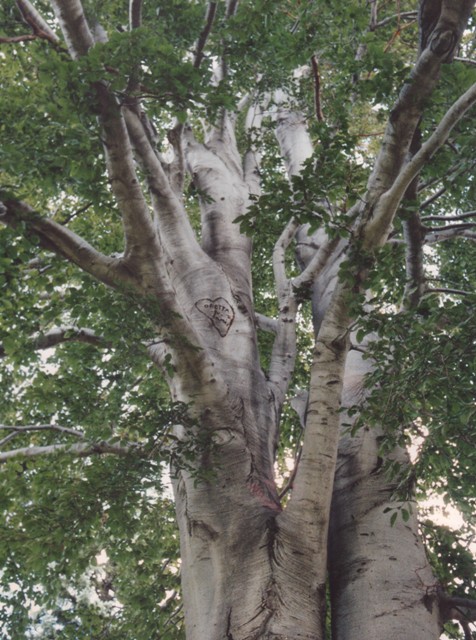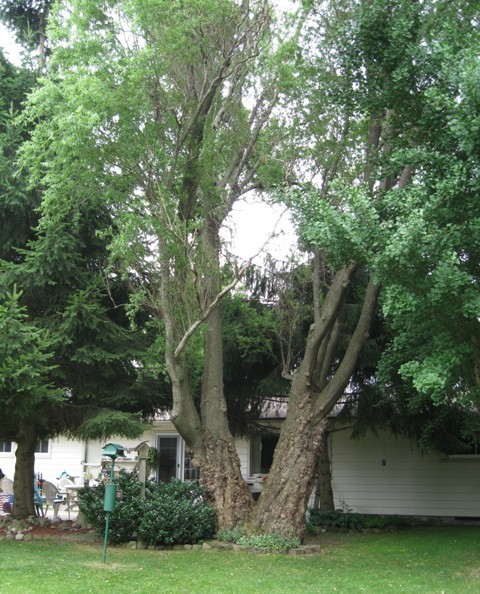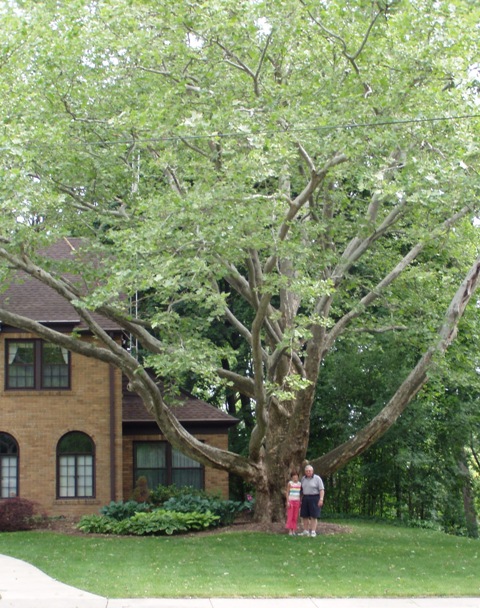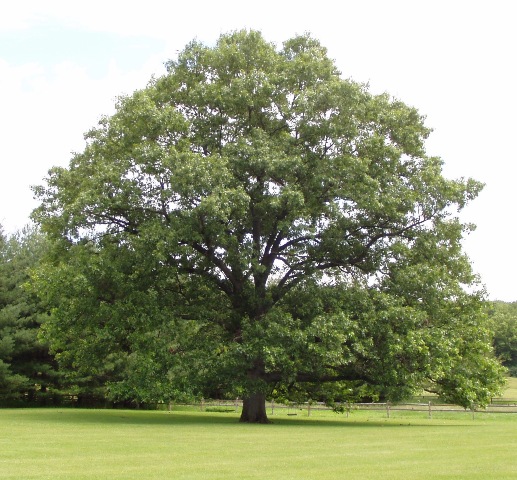The Audubon Society of Jackson County, Michigan
|
- Home
- Programs & Events
- Jackson Big Trees

JACKSON AUDUBON'S BIG TREE SEARCH
Contact: Text Todd Zeller at 517-750-7979
Why the Search?
Why Audubon?
Jackson Audubon has long been involved in promoting an awareness of the importance of trees in our lives. The reasons are obvious. Trees provide birds, Audubon's main focus, with food, nesting sites and protection from both predators and the elements.
Trees also provide man with a wide array of materials that improve our quality of life: wood with which to frame our houses, build our furniture and, for some, heat our homes in winter. The leaves of trees take in carbon dioxide and in turn give off oxygen, thus filtering the air and providing man with one of the essentials of life.
Trees provide shade in the summer, visual wonders in the fall, wind breaks in the winter and flowers in the spring. It is any wonder then that we seek to find, protect and preserve these special friends of ours?
We urge those visiting this web site, whether a member of Audubon or not, to join us in our annual campaign that dates back to the 1970s. Help us find, nominate and confirm the largest trees of each species in Jackson County.
GETTING INVOLVED
How does someone interested in the Big Tree Search become a part of the county-wide effort to find those special specimens of the many species found in southern Michigan? Overcoming inertia (in other words, getting moving) is probably the biggest obstacle one has to overcome. We suggest three relatively easy steps to get started.
Awareness:
Start by examining the trees in your own back yard (you might be surprised). Do a little reading of basic references on the trees of Michigan (both books from the library or a search on the Internet will suffice).
Take a personal tour:
On a sunny day, a walk around your block will bring into focus dozens of new tree discoveries if your eyes are really open and your mind receptive. Jackson Audubon can also provide a list of all county champion trees on public lands. Some are undoubtedly within a short distance of your home.
Make contact:
Getting together with others who are interested in the search is probably the single most significant way to really get involved. Join Audubon! Membership applications are available here.

Jackson County's state champion Copper Beech, only recently fallen due to disease and a lightning strike, originally occupied the front lawn of the St. Joseph Orphanage on Blackstone Street.

This county champ Redbud makes a brilliant show of color in spring in front of the Carnegie Library in downtown Jackson.

An unusual species from Asia, the Amur Honeysuckle is located in a private backyard in Jackson.

Jackson Audubon places brass plates on public champion trees if the tree is healthy and large enough. In this case, a venerable Sugar Maple in eastern Jackson County is so honored.

This American Sycamore, fourth largest in the county, is a special guest in the front lawn of a home in Jackson.

This large Black Oak can be found in the backyard of a rural home in the county.

Black Maple-Champ

Blossoms of an Ohio Buckeye


Current Butternut White Walnut Champ

Current Northern Catalpa Champion
Here are the current county champs (Common Name, Scientific Name) and the record so far as pertains to width. We are still looking for champs of those species without measurements.
Alder, European (Ainus glutinosa):
Apple, Common (Malus pumila): 131"
Apple, Prairie Crab (Malus poensis):
Apple, Wild Sweet Crab (Malus coronaria):
Ash, Black (Fraxinus nigra):
Ash, Blue (Fraxinus quadrangulata):
Ash, Green (Fraxinus pennsylvanica):
Ash, White (Fraxinus americana): 222"
Aspen, Bigtooth (Populus grandidentata): 73"
Aspen, Trembling, Quaking (Populus tremuloides): 47"
Bald Cypress (Taxodium distichum): 26"
Basswood, Large-leafed (Tilia platphilos scopoli): 132"
Basswood, Linden (Tilia americana): 163"
Beech, American (Fagus grandifolia): 113"
Beech, Copper (Fagus sylvatica atropun.): 140"
Beech, European (Fagus sylvatica): 146"
Beech, Tri-color (Fagus sylvatica R-M): 66"
Birch, Cut-leafed (Betula albosinensis):
Birch, European White (Betula pendula Roth): 77"
Birch, River (Betula nigra): 74"
Birch, White, Paper (Betula papyrifera):
Birch, Yellow (Betula alleghaniensis): 65"
Catalpa, Northern, Hardy (Catalpa speciosa): 168"
Cedar, Northern White (Truja occidentalis): 144"
Cherry, Black (Prunus serotina): 204"
Cherry, Choke (Prunus virginiana): 70"
Cherry, Pin (Prunus pennsylvanica): 178"
Cherry, Sour (Prunus cerasus):
Cherry, Sweet (Prunus avium): 57"
Chestnut American (Castanea dentata): 124"
Coffeetree, Kentucky (Gymnocladus dioicus): 106"
Cork, Amur (Phellodendron amurense): 114"
Cottonwood, Eastern (Populus deltoides): 274"
Cottonwood, Swamp (Populus heterophylvia):
Dogwood, Alternate-leaf (Cornus alterfolia): 13"
Dogwood, Flowering (Cornus florida): 21"
Dogwood, Red-osier (Cornus stolonifera): 5"
Eastern Redcedar, Juniper (Juniperus virginiana): 89"
Elm, American (Ulmus americana): 221"
Elm, Camperdown (Ulmus vegeta x): 102"
Elm, Red, Slippery (Ulmus rubra):
Elm, Rock, Cork (Ulmus Thomasii):
Elm, Siberian (Ulmus pumila): 91"
Empress Tree (Paulownia tomentosa): 44"
Fir, Balsam (Abies balsamea):
Fir, Douglas (Psuedotsuga menziesti): 66"
Fir, White (Abies concolor):
Gingko, Maidenhair (Gingko bilboa): 108"
Hackberry, Northern (Celtis occidentalis):
Hawthorn, Cockspur (Crataegus crus-galli): 28"
Hemlock, Eastern (Tsuga canadensis): 98"
Hickory, Bitternut (Carya cordiformis): 90"
Hickory, Mockernut (Carya tomentosa): 130"
Hickory, Pignut (Carya glabra): 122"
Hickory, Snagbark (Carya ovata): 102"
Hickory, Shellbark (Carya lacinosa):
Holly, American (Ilex opaca):
Holly, European (Ilex aquifolium): 17"
Honeylocust (Gleditsia triacanthos): 111"
Honeylocust, Sunburst (Gleditsia triacanthos f.) 70"
Honeysuckle, Amur (Lonicera maacki): 49"
Hop-hornbeam Eastern (Ostrya virginiana): 40"
Hornbeam, American (Caprinus caroliniana): 25"
Horsechestnut (Aesculus hippocastanu): 104"
Horsechestnut, Buckeye (Aesculus glabra): 62"
Locust, Black (Robinia pseudoacacia): 194"
Magnolia, Cucumber (Magnolia acuminata): 130"
Magnolia, Umbrella (Magnolia tripetalia): 40"
Maple, Amur (Acer ginnala Maxim): 35"
Maple, Ashleaf, Boxelder (Acer negundo):
Maple, Black (Acer nigrum): 186"
Maple, Chalk (Acer leucoderme):
Maple, Hedge, English, Field (Acer campestre): 83"
Maple, Norway (Acer platanoides):
Maple, Red (Acer rubrum):
Maple, Silver (Acer saccharomum): 267"
Maple, Sugar (Acer saccharum): 190"
Maple, Sycamore (Acer pseudo-platanus): 80"
Mountain Ash, American (Sorbus americana):
Mountain Ash, European (Sorbus aucuparia): 30"
Mulberry, Red (Morus rubra): 144"
Mulberry, White (Morus alba):
Nannyberry (Viburnam lentago): 14"
Oak, Black (Quercus velutina): 210"
Oak, Bur (Quercus macrocarpa): 237"
Oak, Chestnut (Quercus prinus): 62"
Oak, Chinkapin, Yellow (Quercus muehlenbergii): 14"
Oak, English (Quercus robur): 79"
Oak, Hawkins (Quercus hawkingiae): 46"
Oak, Northern Pin (Quercus ellipsoidalis): 110"
Oak, Overcup (Quercus Iyrata):
Oak, Pin (Quercus palustris): 81"
Oak, Post (Quercus stellata):
Oak, Red (Quercus rubra): 236"
Oak, Scarlet (Quercus coccinea): 205"
Oak, Shingle (Quercus imbricaria): 118"
Oak, Swamp White (Quercus bicolor): 163"
Oak, White (Quercus alba): 231"
Olive, Russian (Elaeagnus angustifolia):
Osage-orange, Bois d'Arc (Maclura pomifera): 105"
Pagoda-tree (Sophora japonica): 42"
Pawpaw (Asimina trioba):
Pear, Common (Pyrus communis): 78"
Pecan (Carya illinoensis):
Persimmon (Dipspryos virginiana): 50"
Pine, Black, Austrian (Pinus nigra): 98"
Pine, Eastern White (Pinus strobus): 126"
Pine, Jack (Pinus banksiana):
Pine, Red (Pinus resinosa): 115"
Pine, Scotch (Pinus sylvestris): 90"
Plum, American (Prunus americana):
Poplar, Balsam (Populus balsamifera):
Poplar, White, Silver (Populus alba): 108"
Prickly-ash, Common (Zanthoxylum americanum):
Redbud, Eastern (Cercis canadensis): 41"
Redwood, Dawn (Metasequoia glyptostro): 85"
Sassafras (Sassafras albidum): 145"
Serviceberry, Downy (Amelanchier arborea): 19"
Smoketree, American (Cotinus oboratus): 10"
Spruce, Black (Picea mariana):
Spruce, Colorado Blue (Picea pungens): 66"
Spruce, Norway (Picea abies): 179"
Sumac, Staghorn (Rhus typhina): 13"
Sweetgum (Liquidambar styracifus): 71"
Sycamore (Plantanus occidentalis): 218"
Sycamore, London Planetree (Plantanus x acerifolia): 79"
Tamarack, American (Larix laricina): 71"
Tuliptree, Yellow Poplar (Lirondendron tulipfera): 148"
Tupelo, Blackgum (Nyssa sylvatica): 14"
Walnut, Black (Juglens nigra): 173"
Walnut, English (Juglens regia): 66"
Walnut, White, Butternut (Juglens cinerea): 160"
Willow, Black (Salix nigra): 174"
Willow, Corkscrew (Salix matsudana): 108"
Willow, Crack (Salix fragilis): 92"
Willow, Pussy (Salix discolor):
Willow, Sandbar (Salix exigua): 48"
Willow, Shining (Salix lucida):
Willow, Weeping (Salix babylonica): 246"
Willow, White (Salix alba): 146"
Witch-hazel (Hamamelis virginiana): 6"
Yellow-wood (Cladrastis kentuckea): 16"
If you would like a nomination form for the Big Tree Search, or if you would like information that shows where all public Big Trees are located, text Todd Zeller at 517-750-7979.
The Michigan Big Tree Program is managed by the Michigan Botanical Club. http://michbotclub.org/
